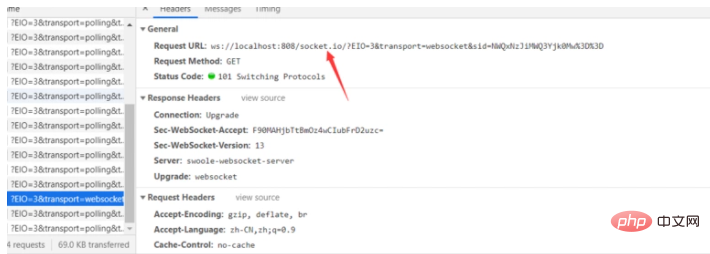下面由thinkphp/" target="_blank">thinkphp框架教程栏目给大家介绍thinkphp 6.0 swoole扩展websocket使用教程(think-swoole),希望对需要的朋友有所帮助!
thinkphp 6.0 swoole扩展websocket使用教程(think-swoole)
最新版本的TP-SWOOLE变化很大,该文所提供的方法已经无法使用,可以参考 https://github.com/xavieryang007/think-swoole-demo/blob/master/doc/%E6%96%87%E6%A1%A3/4.1-websocket.md
即将推出的tp6.0,已经适配swoole.并推出think-swoole 3.0,并且默认适配了socketio。和2.0版本在使用方法上面有些许不同。
Websocket 继承与Http,进行websocket连接之前需要一次HTTP请求,如果当期地址支持websocket则返回101,然后进行连接。也就是说并不是我的服务支持websocket后,请求每个连接地址都可以进行websocket连接,而是需要预先适配才可以连接。
立即学习“PHP免费学习笔记(深入)”;
如果要使用websocket需要在配置中启用,将websocket下的enable设置为true
'server' => [
'host' => '0.0.0.0', // 监听地址
'port' => 808, // 监听端口
'mode' => SWOOLE_PROCESS, // 运行模式 默认为SWOOLE_PROCESS
'sock_type' => SWOOLE_SOCK_TCP, // sock type 默认为SWOOLE_SOCK_TCP
'options' => [
'pid_file' => runtime_path() . 'swoole.pid',
'log_file' => runtime_path() . 'swoole.log',
'daemonize' => false,
// Normally this value should be 1~4 times larger according to your cpu cores.
'reactor_num' => swoole_cpu_num(),
'worker_num' => swoole_cpu_num(),
'task_worker_num' => 4,//swoole_cpu_num(),
'enable_static_handler' => true,
'document_root' => root_path('public'),
'package_max_length' => 20 * 1024 * 1024,
'buffer_output_size' => 10 * 1024 * 1024,
'socket_buffer_size' => 128 * 1024 * 1024,
'max_request' => 3000,
'send_yield' => true,
],
],
'websocket' => [
'enabled' => true,// 开启websocket
'handler' => Handler::class, //自定义wbesocket绑定类
'parser' => Parser::class, //自定义解析类
'route_file' => base_path() . 'websocket.php',
'ping_interval' => 25000,
'ping_timeout' => 60000,
'room' => [
'type' => TableRoom::class,
'room_rows' => 4096,
'room_size' => 2048,
'client_rows' => 8192,
'client_size' => 2048,
],
],
'auto_reload' => true,
'enable_coroutine' => true,
'resetters' => [],
'tables' => [],
handler和parser大大方便了自定义websocket服务,默认系统集成socketio。
本文主要介绍如何使用socketio,这里假设大家有socketio有一定了解和使用基础。
socketIo默认会在请求地址后加相应的参数
同时,socketio默认情况下,会认为 http://url/socket.io/ 是支持websocket服务的地址。

而在tp-swoole3.0内部已经对该地址请求进行了处理
<?php namespace think\swoole\websocket\socketio;
use think\Config;
use think\Cookie;
use think\Request;
class Controller
{
protected $transports = ['polling', 'websocket'];
public function upgrade(Request $request, Config $config, Cookie $cookie)
{
if (!in_array($request->param('transport'), $this->transports)) {
return json(
[
'code' => 0,
'message' => 'Transport unknown',
],
400
);
}
if ($request->has('sid')) {
$response = response('1:6');
} else {
$sid = base64_encode(uniqid());
$payload = json_encode(
[
'sid' => $sid,
'upgrades' => ['websocket'],
'pingInterval' => $config->get('swoole.websocket.ping_interval'),
'pingTimeout' => $config->get('swoole.websocket.ping_timeout'),
]
);
$cookie->set('io', $sid);
$response = response('97:0' . $payload . '2:40');
}
return $response->contentType('text/plain');
}
public function reject(Request $request)
{
return json(
[
'code' => 3,
'message' => 'Bad request',
],
400
);
}
}
TP6.0,插件注册采用了service方式进行了注册,可在tp-swoole 服务注册文件中查看路由注册信息,如果想自定义链接规则,则可以覆盖该路由。
<?php // +----------------------------------------------------------------------
// | ThinkPHP [ WE CAN DO IT JUST THINK IT ]
// +----------------------------------------------------------------------
// | Copyright (c) 2006-2018 http://thinkphp.cn All rights reserved.
// +----------------------------------------------------------------------
// | Licensed ( http://www.apache.org/licenses/LICENSE-2.0 )
// +----------------------------------------------------------------------
// | Author: yunwuxin <448901948@qq.com>
// +----------------------------------------------------------------------
namespace think\swoole;
use Swoole\Http\Server as HttpServer;
use Swoole\Websocket\Server as WebsocketServer;
use think\App;
use think\Route;
use think\swoole\command\Server as ServerCommand;
use think\swoole\facade\Server;
use think\swoole\websocket\socketio\Controller;
use think\swoole\websocket\socketio\Middleware;
class Service extends \think\Service
{
protected $isWebsocket = false;
/**
* @var HttpServer | WebsocketServer
*/
protected static $server;
public function register()
{
$this->isWebsocket = $this->app->config->get('swoole.websocket.enabled', false);
$this->app->bind(Server::class, function () {
if (is_null(static::$server)) {
$this->createSwooleServer();
}
return static::$server;
});
$this->app->bind('swoole.server', Server::class);
$this->app->bind(Swoole::class, function (App $app) {
return new Swoole($app);
});
$this->app->bind('swoole', Swoole::class);
}
public function boot(Route $route)
{
$this->commands(ServerCommand::class);
if ($this->isWebsocket) {
$route->group(function () use ($route) {
$route->get('socket.io/', '@upgrade');
$route->post('socket.io/', '@reject');
})->prefix(Controller::class)->middleware(Middleware::class);
}
}
/**
* Create swoole server.
*/
protected function createSwooleServer()
{
$server = $this->isWebsocket ? WebsocketServer::class : HttpServer::class;
$config = $this->app->config;
$host = $config->get('swoole.server.host');
$port = $config->get('swoole.server.port');
$socketType = $config->get('swoole.server.socket_type', SWOOLE_SOCK_TCP);
$mode = $config->get('swoole.server.mode', SWOOLE_PROCESS);
static::$server = new $server($host, $port, $mode, $socketType);
$options = $config->get('swoole.server.options');
static::$server->set($options);
}
}
Socketio默认使用demo
nbsp;html>
<meta>
<title>Title</title>
<script></script><script>
const socket = io('http://localhost:808');
socket.emit("test", "your message");
socket.on("test",function(res){console.log(res)});
</script>
在app目录下新建websocket.php文件,其中需要注意,由于使用了反射,闭包参数名称不能随意定义,不然无法注入。第一个参数是websocket,是当前websocket的Server对象,第二个参数data是客户端发送的数据。其中socketio emit的第一个参数和Websocket::on的第一个参数一致,作为事件名称。
<?php /**
* Author:Xavier Yang
* Date:2019/6/5
* Email:499873958@qq.com
*/
use \think\swoole\facade\Websocket;
Websocket::on("test", function (\think\swoole\Websocket $websocket, $data) {
//var_dump($class);
$websocket->emit("test", "asd");
});
Websocket::on("test1", function ($websocket, $data) {
$websocket->emit("test", "asd");
});
Websocket::on("join", function (\think\swoole\Websocket $websocket, $data) {
$websocket->join("1");
});

参考如上方法即可使用全新的websocket服务。当然tp-swoole3.0同样还有许多其他的新功能,这些功能需要大家去摸索尝试。
我也会在接下来的文章中,一起与大家分享我的使用过程。